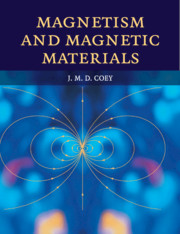Book contents
- Frontmatter
- Contents
- List of tables of numerical data
- Preface
- Acknowledgements
- 1 Introduction
- 2 Magnetostatics
- 3 Magnetism of electrons
- 4 Magnetism of localized electrons on the atom
- 5 Ferromagnetism and exchange
- 6 Antiferromagnetism and other magnetic order
- 7 Micromagnetism, domains and hysteresis
- 8 Nanoscale magnetism
- 9 Magnetic resonance
- 10 Experimental methods
- 11 Magnetic materials
- 12 Applications of soft magnets
- 13 Applications of hard magnets
- 14 Spin electronics and magnetic recording
- 15 Special topics
- Appendices
- Formula index
- Index
- Tables, conversions, constants and units
14 - Spin electronics and magnetic recording
Published online by Cambridge University Press: 05 June 2012
- Frontmatter
- Contents
- List of tables of numerical data
- Preface
- Acknowledgements
- 1 Introduction
- 2 Magnetostatics
- 3 Magnetism of electrons
- 4 Magnetism of localized electrons on the atom
- 5 Ferromagnetism and exchange
- 6 Antiferromagnetism and other magnetic order
- 7 Micromagnetism, domains and hysteresis
- 8 Nanoscale magnetism
- 9 Magnetic resonance
- 10 Experimental methods
- 11 Magnetic materials
- 12 Applications of soft magnets
- 13 Applications of hard magnets
- 14 Spin electronics and magnetic recording
- 15 Special topics
- Appendices
- Formula index
- Index
- Tables, conversions, constants and units
Summary
Conventional electronics has ignored the spin on the electron
Spin electronics exploits the angular momentum and magnetic moment of the electron to add new functionality to electronic devices. A first generation of devices comprised magnetoresistive sensors and magnetic memory. The sensors have numerous applications, especially in digital recording. Magnetic recording uses semihard magnetic thin films as the recording media. Write heads are miniature thin-film electromagnets, while read heads are usually spin-valves exhibiting giant magnetoresistance (GMR) or tunnelling magnetoresistance (TMR). Magnetic randomaccess memory (MRAM) is based on switchable spin valve cells, similar in structure to the read head. New generations of spin electronic devices are under development in which the angular momentum of a spin-polarized current is used to exert spin transfer torque, or the flow of spin-polarized electrons is controlled via a third electrode in a transistor-like structure.
A hugely successful electronics technology has been built around the manipulation of electronic charge in semiconductor microcircuits. The operations needed for computation are conducted using complementary metal-oxide semiconductor (CMOS) logic. The semiconductors can be doped n- or p-type so that the charge carriers may be electrons or holes. Binary data are stored as charge on the gates of field-effect transistors (FETs). An important feature of CMOS logic, Fig. 14.1 is that it only consumes power when the transistors are switching between the on and off states. It is scalable technology, which has been repeatedly miniaturized since its introduction in 1982.
- Type
- Chapter
- Information
- Magnetism and Magnetic Materials , pp. 494 - 541Publisher: Cambridge University PressPrint publication year: 2010



